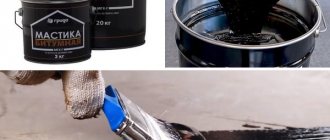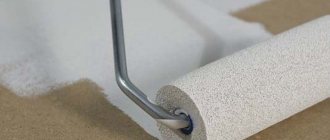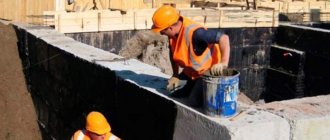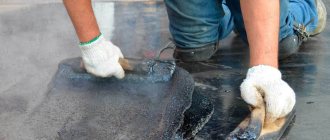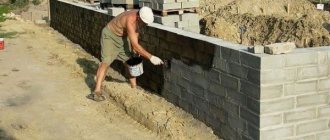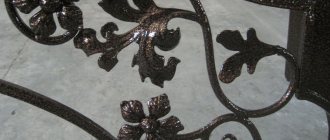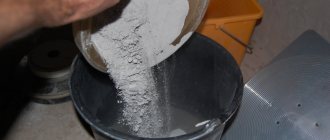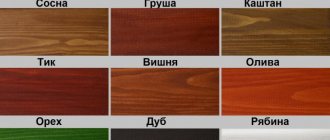What is bitumen mastic
This is modified petroleum bitumen in its pure form, to which additives for various purposes have been added. It is the latter that smooth out some of the negative aspects of this waterproofing material. For example, its high fluidity or cracking at low temperatures.
In appearance, roofing mastic is a pasty substance of black color, highly saturated. This is a ready-made roofing material that does not need to be diluted or heated with anything. The main requirement is to use at positive temperatures.
Bitumen mastic - black paste Source alfakrov.com
Installation technology
Ruberoid refers to rolled roofing materials; it is produced on the basis of special cardboard with a density of 200-420 g/m2 and petroleum bitumen. It is used for a reliable, strong and durable waterproofing coating, any layer of which increases the protective functions of the material. Roofing felt is laid using 3 main methods:
- Mechanical. Laying and securing roofing felt using roofing felt nails is called mechanical. Previously, this technology was popular due to the lack of worthy alternatives. But it is irrational to fix any layer of material, violating the integrity of the roofing material. This fastening method reduces the operating time and waterproofing properties.
- Deposition. Laying roofing material by fusing requires the use of special equipment; it cannot be carried out on flammable substrates. This technology involves the use of grades of roofing felt, on the underside of which fusible bitumen is applied, which is melted by a gas burner during installation.
- Gluing. The laying of roofing felt using the gluing method is carried out using a special composition called mastic. Any layer of waterproofing coating is coated with this bitumen substance, and after drying it is securely glued. Currently, this method is considered the most reliable, since it results in a seamless, monolithic roof.
Note! The use of homemade bitumen mastic or purchased in a store makes it possible to purchase a reliable waterproofing coating that does not allow moisture to pass through. Any glued layer of roofing material increases the protective properties and service life of the roofing material.
Where and how to use it
Since we are talking about the roofing option, we therefore use it on roofs. There are three use cases here:
- on flat roofs as waterproofing and adhesive composition for soft roofs (roofing felt, glass hydroisol and others);
- on pitched roofs as an adhesive during the process of covering some areas with bituminous shingles;
- as a roofing covering if rubber, rubber or latex are added to the mastic.
As for the application method, there are no complex variations here. To do this, use paint rollers, brushes or spatulas. To completely cover the roof plane, special equipment is used that supplies the roofing bitumen coating under pressure, for which the equipment includes an air compressor.
Mastic is used to create roofing. Source propodval.ru
See also: Contacts of construction companies that offer roofing services of any complexity.
Gluing on TechnoNIKOL: brief instructions
Modern and high-tech tools do not require certain preparatory work. Just follow the instructions:
- Prepare the surface for applying mastic: clean it from dust, dirt and other construction impurities. If there is old material (such as tar) on the roof, remove it completely. Dry the surface.
- Fix uneven areas and cracks with concrete mortar.
- Apply a special primer that will make the surface smoother, which will ensure a tight fit.
- Apply glue using a notched trowel, carefully covering the joints with other elements.
- Apply a strip of roofing felt and roll it with a roller from the middle to the edges. If air bubbles have formed, pierce them and distribute the canvas over the surface.
- Place the next sheet with an overlap of 10 cm.
- Additionally, lubricate the joints of the panels.
- Let the first coat dry for 12 hours. Then apply the second and third (if necessary) according to the same pattern.
Important! Do not use mastic in enclosed spaces. When working with the composition, wear suitable clothing and gloves.
Main advantages
We must pay tribute to bitumen mastic for roof waterproofing for its characteristics. It was they who determined the popularity of this material. Its advantages include the following characteristics:
- high elasticity, which allows the applied layer to stretch at high temperatures without tearing, and at low temperatures not to shrink much;
- high tensile strength, this allows you not to worry that the coating at the junction with other planes (for example, with a protruding pipe on the roof) will separate or tear due to temperature changes or light mechanical loads;
- long-term operation, which corresponds to the service life of the same soft rabbit, and this is within 15-25 years;
- low price compared to other types of waterproofing materials and adhesives;
- high resistance to aggressive environments and natural loads;
- ease of application on the surfaces of various building materials;
- the latest types of mastic do not even require cleaning the surface from rust, paint and other contaminants;
- in its pure form, mastic applied to the roof structure, even in 2-3 layers, will be much easier than installing the same soft roof;
- ease of repair of a roof covered with roofing mastic;
- viscosity, which determines the thickness of the applied coating, that is, the layer is not applied too thin.
Easy to apply to roofs of buildings Source ms.decorexpro.com
And as for the disadvantages. There are few of them, but they are there:
- Weather conditions affect the ability to use this bitumen material.
- It is almost impossible to control the thickness of the layer being laid.
- If there are a large number of defects on the surface being poured, for example, bumps, protrusions, pits, then such a surface must be well prepared, smoothing out all the defects, or the thickness of the mastic layer must be increased, that is, the material consumption must be increased, thereby smoothing out the unevenness of the roofing surface being treated.
Basic methods of fixing roofing felt
Ruberoid is a complex material from the point of view of its attachment to the roof surface, but its low price and the ability to install it on any roof make it popular. It can also be used as a waterproofing layer when laid on the foundation.
Previously, a method was used in which the bitumen sheet was laid layer by layer and nailed. Practice has shown that this is short-lived, so today this method is practically not used.
Gluing roofing felt using a special mastic greatly simplified the work with the roofing material. This coating is durable, with joints that do not leak. A significant disadvantage is the mandatory heating of the composition for gluing roofing felt. This requires special devices, which is not very convenient, especially when working independently.
Modern bitumen-based compositions are an ideal option that does not require additional preparation. Among the most famous types of glue:
- TechnoNIKOL,
- ABIZOL KL DM TYTAN,
- AquaMast.
Adhesives provide not only reliable fastening of roofing material to the surface, but also good sealing of joints.
Types of bitumen mastics for roofing
In principle, the proposed classification is conditional. It has three positions:
- Cold roof mastic This is a ready-to-use material. If there is a need for the composition to become more liquid, then it is diluted with solvents. But it should be noted that the mastic may not remain in a diluted state for long. It quickly pushes out any liquid, becoming viscous again. Therefore, the diluted mass must be used immediately. If the temperature outside is close to zero degrees, then the mastic mass must be heated to a temperature of +30 or +40C before using it on the roof.
Bituminous mastic for cold application Source ms.decorexpro.com
Cold styling method
Cold method of laying roofing felt: a - rolling out and trying on a roll; b - gluing the end of the panel to the mastic, feeding the mastic with a fishing rod and leveling it with a paddle; c - rolling out the cloth; d - rolling the panel with a roller.
This method is the most common. In order to do everything correctly, you need to prepare:
- lining material;
- roofing felt;
- bitumen primer for priming;
- bitumen mastic;
- brush or roller;
- knife.
You need to start work by preparing the surface. There should be no cracks, potholes or chips on the base; the surface should be smooth and dry. If there are any shortcomings, then they should be corrected, for which use cement mortar or waterproofing mastic. All surface transitions (if any) should not have sharp changes. Otherwise, the coating will not lie tightly on the roof.
Since this is a rolled material, before use it must be rolled out and left to level for a day. Before installation, roll it again.
All work should be carried out in warm, dry weather. If the old flooring is in poor condition, it is dismantled. If necessary, a new cement-sand screed is made. After this, it is the turn of the bitumen primer, a special solution with high penetrating and wetting ability. It dries quickly, reducing work time. It is applied over the entire roof area using a brush or roller.
The next stage is the preparation of bitumen mastic, the type of which depends on the type of roofing material used. It should be viscous and fluid, reminiscent of hot bitumen. If this is not the case, then it should be warmed up.
Fitting and styling
Mechanical method of laying roofing felt: rolls are nailed to the sheathing.
First you need to try it on site and make all the necessary cuts. The roofing felt is laid with an overlap of at least 10 cm. The next layer overlaps the joints of the previous one. You should apply the mastic to a small area, and, gradually rolling out the roll, glue it, pressing it tightly to the surface. Lay it in several layers, using finely sprinkled material for the interior. The outer layer should have a coarse-grained material. In the place where the layers will overlap, the layer of mastic should be large.
When using roofing felt, which is based on fiberglass, two layers of installation are sufficient. This material is durable and reliable. When using regular, the number of layers should be at least four. In sloping areas and on uneven surfaces, two will suffice.
Rules for applying bitumen mastic to the roof
We will not consider here how bitumen waterproofing mastic is used for roofing when laying soft roofing or flexible tiles. These technologies are simple because the material is simply applied to the surface with a spatula, roller or brushes. A more complex process is creating a roofing covering using the mastic itself. We'll tell you about this.
First of all, it should be noted that bitumen mastic is laid on the surface of flat roofs after cleaning the latter. Therefore, if reconstruction is carried out, that is, replacing the old covering with a new one, then it is necessary to completely tear off the old roof, remove the old adhesive composition by any means to the concrete surface of the ceiling. The latter is cleared of debris, dusted and treated with a bitumen primer.
Roof treatment with bitumen primer Source an-maximum.ru
Now to the question of how many layers should be used when applying mastic.
- If the roof slope does not exceed 10°, then three layers are laid, each of which must be dried before laying the next one. In this case, a reinforcing fiberglass mesh must be placed between the layers. The last freshly laid layer can be filled with fine crushed stone or gravel.
- If the angle of inclination of the roof slope is in the range of 10-20°, then two layers are laid with one reinforcing layer between them. The top of a bitumen roof can be painted.
- If the angle of inclination exceeds 20°, then apply a single-layer coating with a thickness of at least 3 mm, which is covered with paint on top. Although experts recommend not reducing the number of layers to less than two.
The thickness of the applied bitumen layers should not be less than 1 mm. The material itself is applied either by pouring, when the mastic is poured and distributed over the surface to be treated with mops and scrapers, or by spraying under pressure. The first option is considered expendable, because it is difficult to level layers of a certain thickness. By the way, it should be noted that the average consumption of bitumen mastic on rabbits is 1.5 kg/m².
And a few words about the price of bitumen mastic. Of all the brands offered, the cheapest is bitumen-polymer mastic (MBM). One bucket weighing 16 kg costs between 900-1000 rubles. Bitumen-rubber mastic costs from 2000 rubles per bucket weighing 20 kg.
TechnoNIKOL glue
TechnoNIKOL is a bitumen-based composition using modern modifying additives, solvents and fillers. It is used for working with roofing felt of all brands, as well as with glass insulation and other rolled materials used in construction for waterproofing. Bitumen mastic glues the roof to concrete, cement-sand and other bases.
Note! Before laying roofing felt on glue, preparatory work is required. The adhesive composition is applied only to a clean coating.
The glue can be used at temperatures from +5 to +35 °C. At a relatively low price (500–600 rubles per 10 liters), the quality of the product meets international standards. The only disadvantage when working with mastic is the high consumption - 1.5–2 kg per 1 sq. m. m.
Application methods for waterproofing
Before you begin applying a layer of waterproofing, you must carefully prepare the surface. The preliminary stage consists of cleaning the base from debris and dust, as well as mandatory wet cleaning and drying of the surface.
Depending on the type of base, the following types of preparation are performed:
- mineral porous surfaces are treated with a primer or primer (especially important for applying hot mastics);
- metal structures are cleaned of rusty deposits;
- The concrete surface can only be vacuumed.
The volume of bitumen-rubber mastic for waterproofing applied to the surface is directly dependent on the need to heat the material and the solvent used. There is no need to prepare the mastic in any special way. It is already sold as a finished material that just needs to be mixed.
Types and use of mastic for roofing felt on the roof - tips from practice
Ruberoid has been used for roofing work for a very long time and during this time it has gained fame as the most reliable budget material. Roofing felt is based on roofing cardboard, impregnated with petroleum bitumen and coated with special crumbs. This material is successfully used for roofing work on commercial or industrial facilities.
For installation and repair of roofing felt coatings, it is necessary to use special mastics, available on the market in a wide range. How to seal roofing felt on the roof will be discussed in this article.
Professional advice on choosing
We have prepared for you several useful videos devoted to the nuances of choosing and using roofing mastic. After watching these videos, you will see with your own eyes all the stages of work and get acquainted with the experience of professionals in the field of roofing work:
If the technology for applying roofing mastic is followed, it is possible to obtain a completely water-impermeable coating that is highly reliable and has a long service life. The main thing is not to rush when applying: carefully prepare the base, distribute the bitumen composition evenly and let each layer dry. Then the result will delight you for many years.
Application of cold composition
First layer. Apply preferably with a brush. Preliminary dilution with a primer (1:2) or a specialized primer is required.
Second layer. You should start only when the first layer is completely dry. At above-zero temperatures this is approximately 6 hours. After which you can reapply the mastic with a spatula. A gun is better suited for sealing seams, small cracks and joints.
Economical way. Allows you to shorten the application time, as well as the consumption of the material itself - spraying with a mechanical spray gun. The total thickness of the layers should not be less than 2 mm.
Applying the hot composition is similar to the cold method, only the scope of application is limited to horizontal surfaces.
Roof repair
Rubber-bitumen mastic has found its application in repair work. Moreover, it is indispensable for eliminating local problems.
So, when the roll material swells, you need to:
- cut the edges of the defective area and bend them with a spatula;
- apply mastic inside and lay reinforced mesh;
- after drying, apply a second coat;
- fold the edges towards the center.
Metal surface repair:
- clean the problem surface from rust;
- apply the first layer of cold mastic (with a sponge or brush);
- After drying, apply a second layer, but with a brush or spray.
Particular attention must be paid to the seams, but not to exceed a total thickness of 4 mm.
Bitumen rubber mastic and its consumption per 1 m2
It will not be possible to make an estimate in advance, plan work and carry out other work if you do not know how much material is required per 1 m2. To determine the consumption of mastic, it will be easiest for you to look at the label, but if it does not have such data, then you can find a note indicating the recommended minimum material for coating with one layer. This way it will be quite easy to calculate how much mastic you will need. Typically, this material consists of 35-70% volatile solvents, which means that the same percentage is inherent in the shrinkage of the bitumen composition after application.
| Foundation waterproofing | From 2.1 to 3 kg/m2 |
| Roof arrangement | From 3.6 to 6.1 kg/m2 |
| Attaching roofing felt | From 1.1 to 2.1 kg/m2 |
Composition and use of mastic
The composition of bitumen mastic is simple, it consists of bitumen, solvents and various structuring additives (chalk, asbestos, peat chips, talc). It is used for installing roofing felt using the gluing method. There are 2 types of mastic, cold and hot, which differ in price, composition and release form. They are considered a multifunctional tool for performing the following tasks:
- Gluing roofing felt. To glue this material to the base of the roof, each layer is coated with bitumen mastic, pressing it against the previous one, smoothing it, eliminating bubbles. After the composition dries, the roofing felt reliably sets, creating a seamless waterproofing coating.
- Priming the base. Using bitumen mastic, the base of the roof is often primed to improve adhesion between materials in order to lay built-up roofing felt. This operation is considered mandatory if the coating is laid on a concrete base, since it has increased porosity and surface roughness.
- Repair of roofing felt roofing. Bituminous mastic is used for spot repairs of small cracks and mechanical damage that appear on roofing felt roofing during operation. To do this, defects on the surface of the roofing material are filled with molten mastic.
- Coating waterproofing. Bituminous mastic is used for coating waterproofing of foundations, walls, pillars and other elements that need protection from moisture.
Important! Mastic based on petroleum bitumen is an additional waterproofing in the roofing pie of roofing material. With the help of this composition, layers of material are reliably glued together without the formation of air bubbles or bumps, forming a monolithic, seamless “carpet”.
Technology for laying roofing felt on the roof
Ruberoid is a rolled roofing material, for the production of which special cardboard with a density of 200-420 g/m2 and bitumen are used. The combination of these materials makes it possible to create a fairly reliable waterproofing material, the effectiveness of which increases with the number of layers laid.
Installation of roofing felt can be carried out in three ways:
- Mechanical . This technology for laying roofing felt is the most traditional and has been used for a very long time, which is due to the lack of alternatives. Mechanical installation of roofing felt involves fastening the material using roofing felt nails. The method is quite simple to implement, but is not very effective in terms of the durability of the structure - the presence of holes in the roofing felt negatively affects its waterproofing properties.
- Deposition . Fused roofing felt roofing technology has some limitations: firstly, special equipment is required to apply the coating, and secondly, this method is not suitable for combustible substrates. The installation technology involves the use of a gas burner, which heats the adhesive layer located on the underside of the roofing material.
- Gluing . To implement this method, various mastics with adhesive properties are used. All laid layers of roofing material are coated with bitumen mastic and securely glued to the roof surface. This method is considered the most effective today, since the result is a monolithic overlap of roofing material on the roof.
